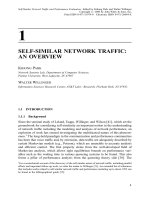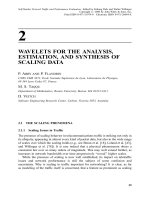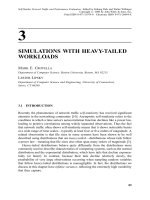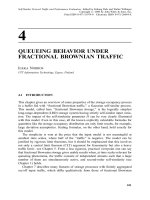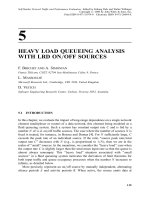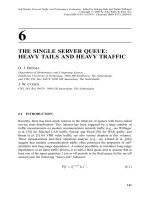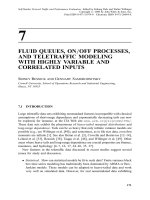Tài liệu Mạng lưới giao thông và đánh giá hiệu suất P14 pptx
Bạn đang xem bản rút gọn của tài liệu. Xem và tải ngay bản đầy đủ của tài liệu tại đây (585.01 KB, 18 trang )
14
THE PROTOCOL STACK AND ITS
MODULATING EFFECT ON
SELF-SIMILAR TRAFFIC
KIHONG PARK
Network Systems Lab, Department of Computer Sciences, Purdue University,
West Lafayette, IN 47907
GITAE KIM AND MARK E. CROVELLA
Department of Computer Science, Boston University, Boston, MA 02215
14.1 INTRODUCTION
Recent measurements of local-area and wide-area traf®c [14, 22, 28] have shown
that network traf®c exhibits variability at a wide range of scales. Such scale-invariant
variability is in strong contrast to traditional models of network traf®c, which show
variability at short scales but are essentially smooth at large time scales; that is, they
lack long-range dependence. Since self-similarity is believed to have a signi®cant
impact on network performance [2, 15, 16], understanding the causes and effects of
traf®c self-similarity is an important problem.
In this chapter, we study a mechanism that induces self-similarity in network
traf®c. We show that self-similar traf®c can arise from a simple, high-level property
of the overall system: the heavy-tailed distribution of ®le sizes being transferred over
the network. We show that if the distribution of ®le sizes is heavy tailedÐmeaning
that the distribution behaves like a power law thus generating very large ®le trans-
fers with nonnegligible probabilityÐthen the superposition of many ®le transfers in
a client=server network environment induces self-similar traf®c, and this causal
Self-Similar Network Traf®c and Performance Evaluation, Edited by Kihong Park and Walter Willinger
ISBN 0-471-31974-0 Copyright # 2000 by John Wiley & Sons, Inc.
349
Self-Similar Network Traf®c and Performance Evaluation, Edited by Kihong Park and Walter Willinger
Copyright # 2000 by John Wiley & Sons, Inc.
Print ISBN 0-471-31974-0 Electronic ISBN 0-471-20644-X
mechanism is robust with respect to changes in network resources (bottleneck
bandwidth and buffer capacity), topology, interference from cross-traf®c with
dissimilar traf®c characteristics, and changes in the distribution of ®le request
interarrival times. Properties of the transport=network layer in the protocol stack are
shown to play an important role in mediating this causal relationship.
The mechanism we propose is motivated by the on=off model [28]. The on=off
model shows that self-similarity can arise in an idealized contextÐthat is, one with
independent traf®c sources and unbounded resourcesÐas a result of aggregating a
large number of 0=1 renewal processes whose on or off periods are heavy tailed. The
success of this simple, elegant model in capturing the characteristics of measured
traf®c traces is surprising given that it ignores nonlinearities arising from the
interaction of traf®c sources contending for network resources, which in real
networks can be as complicated as the feedback congestion control algorithm of
TCP. To apply the framework of the on=off model to real networks, it is necessary to
understand whether the model's limitations affect its usefulness and how these
limitations manifest themselves in practice.
In this chapter, we show that in a ``realistic'' client=server network environmentÐ
that is, one with bounded resources leading to the coupling of multiple traf®c
sources contending for shared resourcesÐthe degree to which ®le sizes are heavy
tailed directly determines the degree of traf®c self-similarity. Speci®cally, measuring
self-similarity via the Hurst parameter H and ®le size distribution by its power-law
exponent a, we show that there is a linear relationship between H and a over a wide
range of network conditions and when subject to the in¯uence of the protocol stack.
The mechanism gives a particularly simple structural explanation of why self-similar
network traf®c may be observed in many diverse networking contexts.
We discuss a traf®c-shaping effect of TCP that helps explain the modulating
in¯uence of the protocol stack. We ®nd that the presence of self-similarity at the link
and network layer depends on whether reliable and ¯ow-controlled communication
is employed at the transport layer. In the absence of reliability and ¯ow control
mechanismsÐsuch as when a UDP-based transport protocol is usedÐmuch of the
self-similar burstiness of the downstream traf®c is destroyed when compared to the
upstream traf®c. The resulting traf®c, while still bursty at short ranges, shows
signi®cantly less long-range correlation structure. In contrast, when TCP (Reno,
Tahoe, or Vegas) is employed, the long-range dependence structure induced by
heavy-tailed ®le size distributions is preserved and transferred to the link layer,
manifesting itself as scale-invariant burstiness.
We conclude with a discussion of the effect of self-similarity on network
performance. We ®nd that in UDP-based non-¯ow-controlled environment, as
self-similarity is increased, performance declines drastically as measured by
packet loss rate and mean queue length. If reliable communication via TCP is
used, however, packet loss, retransmission rate, and ®le transmission time decline
gracefully (roughly linearly) as a function of H. The exception is mean queue length,
which shows the same superlinear increase as in the unreliable non-¯ow-controlled
case. This graceful decline in TCP's performance under self-similar loads comes at a
cost: a disproportionate increase in the consumption of buffer space. The sensitive
350 THE PROTOCOL STACK AND ITS MODULATING EFFECT
dependence of mean queue length on self-similarity is consistent with previous
works [2, 15, 16] showing that queue length distribution decays more slowly for
long-range dependent (LRD) sources than for short-range dependent (SRD) sources.
The aforementioned traf®c-shaping effect of ¯ow-controlled, reliable transport
transforming a large ®le transfer into an on-average ``thin'' packet train (stretch-
ing-in-time effect) suggests, in part, why the on=off model has been so successful
despite its limitationsÐa principal effect of interaction among traf®c sources in an
internetworked environment lies in the generation of long packet trains wherein the
correlation structure inherent in heavy-tailed ®le size distributions is suf®ciently
preserved.
The rest of the chapter is organized as follows. In the next two sections, we
discuss related work, the network model, and the simulation setup. This is followed
by the main section, which explores the effect of ®le size distribution on traf®c self-
similarity, including the role of the protocol stack, heavy-tailed versus non-heavy-
tailed interarrival time distribution, resource variations, and traf®c mixing. We
conclude with a discussion of the effect of traf®c self-similarity from a performance
evaluation perspective, showing its quantitative and qualitative effects with respect to
performance measures when both the degree of self-similarity and network resources
are varied.
14.2 RELATED WORK
Since the seminal study of Leland et al. [14], which set the groundwork for
considering self-similar network traf®c as an important modeling and performance
evaluation problem, a string of work has appeared dealing with various aspects of
traf®c self-similarity [1, 2, 7, 11, 12, 15, 16, 22, 28].
In measurement based work [7, 11, 12, 14, 22, 28], traf®c traces from physical
network measurements are employed to identify the presence of scale-invariant
burstiness, and models are constructed capable of generating synthetic traf®c with
matching characteristics. These works show that long-range dependence is an
ubiquitous phenomenon encompassing both local-area and wide-area network
traf®c.
In the performance evaluation category are works that have evaluated the effect of
self-similar traf®c on idealized or simpi®ed networks [1, 2, 15, 16]. They show that
long-range dependent traf®c is likely to degrade performance, and a principal result
is the observation that queue length distribution under self-similar traf®c decays
much more slowly than with short-range-dependent sources (e.g., Poisson). We refer
the reader to Chapter 1 for a comprehensive survey of related works.
Our work is an extension of the line of research in the ®rst category, where we
investigate causal mechanisms that may be at play in real networks responsible for
generating the self-similarity phenomena observed in diverse networking contexts.
1
H-estimates and performance results when an open-loop ¯ow control is active can be found in Park et al.
[17].
14.2 RELATED WORK
351
The relationship between ®le sizes and self-similar traf®c was explored in Park et al.
[18], and is also indicated by the work described in Crovella and Bestavros [7],
which showed that self-similarity in World Wide Web traf®c might arise due to the
heavy-tailed distribution of ®le sizes present on the Web.
An important question is whether ®le size distributions in practice are in fact
typically heavy-tailed, and whether ®le size access patterns can be modeled as
randomly sampling from such distributions. Previous measurement-based studies of
®le systems have recognized that ®le size distributions possess long tails, but they
have not explicitly examined the tails for power-law behavior [4, 17, 23±25].
Crovella and Bestavros [7] showed that the size distribution of ®les found in the
World Wide Web appears to be heavy-tailed with a approximately equal to 1, which
stands in general agreement with measurements reported by Arlitt and Williamson
[3]. Bodnarchuk and Bunt [6] show that the sizes of reads and writes to an NFS
server appear to show power-law behavior. Paxson and Floyd [22] found that the
upper tail of the distribution of data bytes in FTP bursts was well ®t to a Pareto
distribution with 0:9 a 1:1. A general study of UNIX ®le systems has found
distributions that appear to be approximately power law [13].
14.3 NETWORK MODEL AND SIMULATION SETUP
14.3.1 Network Model
The network is given by a directed graph consisting of n nodes and m links. Each
output link has a buffer, link bandwidth, and latency associated with it. A node
v
i
i 1; 2; ; n is a server node if it has a probability density function p
i
X ,
where X ! 0 is a random variable denoting ®le size. We will call p
i
X the ®le size
distribution of server v
i
. v
i
is a client node (it may, at the same time, also be a server)
if it has two probability density functions h
i
X , d
i
Y , X Pf1; ; ng, Y P R
,
where h
i
is used to select a server, and d
i
is the interarrival time (or idle time
distribution), which is used in determining the time of next request. In the context of
reliable communication, if T
k
is the time at which the kth request by client v
i
was
Fig. 14.1 Network con®guration.
352
THE PROTOCOL STACK AND ITS MODULATING EFFECT
reliably serviced, the next request made by client v
i
is sheduled at time T
k
Y,
where Y has distribution d
i
. Requests from individual clients are directed to servers
randomly (independently and uniformly) over the set of servers. In unreliable
communication, this causal requirement is waived. A 2-server, 32-client network
con®guration with a bottleneck link between gateways G
1
and G
2
is shown in Fig.
14.1. This network con®guration is used for most of the experiments reported below.
We will refer to the total traf®c arriving at G
2
from servers as upstream traf®c and
the traf®c from G
2
to G
1
as downstream traf®c.
A ®le is completely determined by its size X and is split into dX =Me packets,
where M is the maximum segment size (1 kB for the results shown in this chapter).
The segments are routed through a packet-switched internetwork with packets being
dropped at bottleneck nodes in case of buffer over¯ow. The dynamical model is
given by all clients independently placing ®le transfer requests to servers, where
each request is completely detemined by the ®le size.
14.3.2 Simulation Setup
We have used the LBNL Network Simulator (ns) as our simulation environment [8].
Ns is an event-driven simulator derived from S. Keshav's REAL network simulator
supporting several ¯avors of TCP (in particular, the TCP Reno's congestion control
featuresÐSlow Start, Congestion Avoidance, Fast Retransmit=Recovery) and router
scheduling algorithms.
We have modi®ed the distributed version of ns to model our interactive
client=server environment. This entailed, among other things, implementing our
client=server nodes as separate application layer agents. A UDP-based unreliable
transport protocol was added to the existing protocol suite, and an aggressive
opportunistic UDP agent was built to service ®le requests when using unreliable
communication. We also added a TCP Vegas module to complement the existing
TCP Reno and Tahoe modules.
Our simulation results were obtained from several hundred runs of ns. Each run
executed for 10,000 simulated seconds, logging traf®c at 10 millisecond granularity.
The result in each case is a time series of one million data points; using such
extremely long series increases the reliability of statistical measurements of self-
similarity. Although most of the runs reported here were done with a 2-server=32-
client bottleneck con®guration (Fig. 14.1), other con®gurations were tested includ-
ing performance runs with the number of clients varying from 1 to 132. The
bottleneck link was varied from 1.5 Mb=s up to OC-3 levels, and buffer sizes were
varied in the range of 1±128 kB. Non-bottleneck links were set at 10 Mb=s and the
latency of each link was set to 15 ms. The maximum segment size was ®xed at 1 kB
for the runs reported here. For any reasonable assignment to bandwidth, buffer size,
mean ®le request size, and other system parameters, it was found that by adjusting
either the number of clients or the mean of the idle time distribution d
i
appropriately,
any intended level of network contention could be achieved.
14.3 NETWORK MODEL AND SIMULATION SETUP 353
14.4 FILE SIZE DISTRIBUTION AND TRAFFIC SELF-SIMILARITY
14.4.1 Heavy-Tailed Distributions
An important characteristic of our proposed mechanism for traf®c self-similarity is
that the sizes of ®les being transferred are drawn from a heavy-tailed distribution. A
distribution is heavy tailed if
PX > x$x
Àa
as x 3I;
where 0 < a < 2. That is, the asymptotic shape of the distribution follows a power
law. One of the simplest heavy-tailed distributions is the Pareto distribution. The
Pareto distribution is power law over its entire range; its probability density function
is given by
pxak
a
x
ÀaÀ1
;
where a; k > 0, and x ! k. Its distribution function has the form
FxPX x1 Àk=x
a
:
The parameter k represents the smallest possible value of the random variable.
Heavy-tailed distributions have a number of properties that are qualitatively
different from distributions more commonly encountered such as the exponential or
normal distribution. If a 2, the distribution has in®nite variance; if a 1 then the
distribution has also in®nite mean. Thus, as a decreases, a large portion of the
probability mass is present in the tail of the distribution. In practical terms, a random
variable that follows a heavy-tailed distribution can give rise to extremely large ®le
size requests with nonnegligible probability.
14.4.2 Effect of File Size Distribution
First, we demonstrate our central point: the interactive transfer of ®les whose size
distribution is heavy-tailed generates self-similar traf®c even when realistic network
dynamics, including network resource limitations and the interaction of traf®c
streams, are taken into account.
Figure 14.2 shows graphically that our setup is able to induce self-similar link
traf®c, the degree of scale-invariant burstiness being determined by the a parameter
of the Pareto distribution. The plots show the time series of network traf®c measured
at the output port of the bottleneck link from the gateway G
2
to G
1
in Fig. 14.1. This
downstream traf®c is measured in bytes per unit time, where the aggregation level or
time unit varies over ®ve orders of magnitude from 10 ms, 100 ms, 1 s, 10 s, to 100 s.
Only the top three aggregation levels are shown in Fig. 14.2; at the lower aggregation
levels traf®c patterns for differing a values appear similar to each other. For a close
to 2, we observe a smoothing effect as the aggregation level is increased, indicating a
354 THE PROTOCOL STACK AND ITS MODULATING EFFECT
seconds seconds seconds seconds
secondssecondssecondsseconds
seconds seconds seconds seconds
Fig. 14.2 TCP run. Throughput as a function of ®le size distribution and three aggregation levels. File size distributions
constitute Pareto with a 1:05, 1.35, 1.95, and exponential.
355
weak dependency structure in the underlying time series. As a approaches 1,
however, burstiness is preserved even at large time scales, indicating that the
10 ms time series possesses long-range dependence. The last column depicts time
series obtained by employing an exponential ®le size distribution at the application
layer with the mean normalized so as to equal that of the Pareto distributions. We
observe that the aggregated time series between exponential and Pareto with
a 1:95 are qualitatively indistinguishable.
A quantitative measure of self-similarity is obtained by using the Hurst parameter
H, which expresses the speed of decay of a time series' autocorrelation function. A
time series with long-range dependence has an autocorrelation function of the form
rk$k
Àb
as k 3I;
where 0 < b < 1. The Hurst parameter is related to b via
H 1 À
b
2
:
Hence, for long-range dependent time series,
1
2
< H < 1. As H 3 1, the degree of
long-range dependence increases. A test for long-range dependence in a time series
can be reduced to the question of determining whether H is sign®cantly different
from
1
2
.
In this chapter, we use two methods for testing self-similarity.
2
These methods are
described more fully in Beran [5] and Taqqu et al. [23], and are the same methods
used in Leland et al. [12]. The ®rst method, the variance±time plot, is based on the
slowly decaying variance of a self-similar time series. The second method, the R=S
plot, uses the fact that for a self-similar data set, the rescaled range or R=S statistic
grows according to a power law with exponent H as a function of the number of
points included. Thus the plot of R=S against this number on a log±log scale has a
slope that is an estimate of H. Figure 14.3 shows H-estimates based on variance±
time and R=S methods for three different network con®gurations. Each plot shows H
as a function of the Pareto distribution parameter for a 1:05, 1.15, 1.25, 1.35,
1.65, and 1.95.
Figure 14.3(a) shows the results for the baseline TCP Reno case in which network
bandwidth and buffer capacity are both limited (1.5 Mb=s and 6 kB), resulting in an
4% packet drop rate for the most bursty case a 1:05. The plot shows that the
Hurst parameter estimates vary with ®le size distribution in a roughly linear manner.
The H 3 À a=2 line shows the values of H that would be predicted by the on=off
model in an idealized case corresponding to a fractional Gaussian noise process.
Although their overall trends are similar (nearly coinciding at a 1:65), the slope of
the simulated system with resource limitations and reliable transport layer running
TCP Reno's congestion control is consistently less than À1, with an offset below the
2
A third method based on the periodgram was also used. However, this method is believed to be sensitive
to low-frequency components in the series, which led in our case to a wide spread in the estimates; it is
omittted here.
356 THE PROTOCOL STACK AND ITS MODULATING EFFECT
idealized line for a close to 1, and above the line for a close to 2. Figure 14.3(b)
shows similar results for the case in which there is no signi®cant limitation in
bandwidth (155 Mb=s) leading to zero packet loss. There is noticeably more spread
among the estimates, which we believe to be the result of more variability in the
traf®c patterns since traf®c is less constrained by bandwidth limitations. Figure
14.3(c) shows the results when bandwidth is limited, as in the baseline case, but
buffer sizes at the switch are increased (64 kB). Again, a roughly linear relationship
between the heavy-tailedness of ®le size distribution (a) and self-similarity of link
traf®c (H) is observed.
To verify that this relationship is not due to speci®c characteristics of the TCP
Reno protocol, we repeated our baseline simulations using TCP Tahoe and TCP
Vegas. The results, shown in Figure 14.4, were essentially the same as in the TCP
Reno baseline case, which indicates that speci®c differences in implementation of
(a) (b) (c)
Fig. 14.3 Hurst parameter estimates (TCP run): R=S and variance±time for a 1:05, 1.35,
1.65 and 1.95. (a) Base run, (b) large bandwidth=large buffer, and (c) large buffer.
Fig. 14.4 Hurst parameter estimates for (a) TCP Tahoe and (b) TCP Vegas runs with
a 1.05, 1.35, 1.65, 1.95.
14.4 FILE SIZE DISTRIBUTION AND TRAFFIC SELF-SIMILARITY 357
TCP's ¯ow control between Reno, Tahoe, and Vegas do not signi®cantly affect the
resulting traf®c self-similarity.
Figure 14.5 shows the relative ®le size distribution of client=server interactions
over the 10,000 second simulation time interval, organized into ®le size buckets (or
bins). Each ®le transfer request is weighted by its size in bytes before normalizing to
yield the relative frequency. Figure 14.5(a) shows that the Pareto distribution with
a 1:05 generates ®le size requests that are dominated by ®le sizes above 64 kB. On
the other hand, the ®le sizes for Pareto with a 1:95 (Fig. 14.5(b)) and the
exponential distribution (Fig. 14.5(c)) are concentrated on ®le sizes below 64 kB,
and in spite of ®ne differences, their aggregated behavior (cf. Figure 14.2) is similar
with respect to self-similarity.
We note that for the exponential distribution and the Pareto distribution with
a 1:95, the shape of the relative frequency graph for the weighted case is
analogous to the nonweighted (i.e., one that purely re¯ects the frequency of ®le
size requests) case. However, in the case of Pareto with a 1:05, the shapes are
``reversed'' in the sense that the total number of requests are concentrated on small
®le sizes even though the few large ®le transfers end up dominating the 10,000
second simulation run. This is shown in Figure 14.6.
File size bucket (kB) File size bucket (kB) File size bucket (kB)
Relative frequency
Relative frequency
Relative frequency
(Weighted) file size distribution:
exponential
(Weighted) file size distribution:
Pareto 1.95
(Weighted) file size distribution:
Pareto 1.05
Fig. 14.5 Relative frequency of weighted ®le size distributions obtained from three 10,000
second TCP runsÐPareto (a) with a 1:05 and (b) with a 1:95; (c) exponential distribu-
tion.
Fig. 14.6 Relative frequency of unweighted ®le size distributions of TCP runs with Pareto
(a) with a 1.05 and (b) with a 1.95; (c) exponential distribution.
358
THE PROTOCOL STACK AND ITS MODULATING EFFECT
14.4.3 Effect of Idle Time Distribution
All the runs thus far were obtained with an exponential idle time distribution with
mean 600 ms. Figure 14.7(a) and (b) show the H-estimates of the baseline
con®guration when the idle time distribution is exponential with mean 0.6 s and
Pareto with a 1:05 and mean 1.197 s. The ®le size distribution remained Pareto.
As the H-estimates show, the effect of a Pareto-modeled heavy-tailed idle time
distribution is to boost long-range dependence when a is close to 2, decreasing in
effect as a approaches 1.
This phenomenon may be explained as follows. For ®le size distributions with a
close to 2, the correlation structure introduced by heavy-tailed idle time is signi®cant
relative to the contribution of the ®le size distribution, thus increasing the degree of
self-similarity as re¯ected by H.Asa approaches 1, however, the tail mass of the ®le
size distribution becomes the dominating term, and the contribution of idle time with
respect to increasing dependency becomes insigni®cant in comparison.
Figure 14.7(c) shows the Hurst parameter estimates when the ®le size distribution
was exponential with mean 4.1 kB, but the idle time distribution was Pareto with a
ranging between 1.05 and 1.95 and mean 1.197 s at a 1:05. As the idle time
distribution is made more heavy-tailed a 3 1, a positive trend in the H-estimates
is discernible. However, the overall level of H-values is signi®cantly reduced from
the case when the ®le size distribution was Pareto, indicating that the ®le size
distribution is the dominating factor in determining the self-similar characteristics of
network traf®c.
14.4.4 Effect of Traf®c Mixing
Figure 14.8 shows the effect of making one of the ®le size distributions heavy-tailed
a 1:05 and the other one exponential in the 2-server system. Downstream
throughput is plotted against time where the aggregation level is 100 seconds. Figure
14.8(a) shows the case when both servers are Pareto with a 1:05. Figure 14.8(c)
(a) (b) (c)
Fig. 14.7 TCP run: exponential idle time versus Pareto idle time with Pareto ®le size
distributionsÐ(a) variance±time, (b) R=S, (c) Pareto idle times with exponential ®le size
distribution (right).
14.4 FILE SIZE DISTRIBUTION AND TRAFFIC SELF-SIMILARITY 359
shows the case when both servers have exponential ®le size distributions. Figure
14.8(b) is the combined case, where one server has a Pareto distribution with
a 1:05 and the other server has an exponential distribution. Figure 14.8 shows that
the mixed case is less ``bursty'' than the pure Pareto case but more bursty than the
pure exponential case. Performance indicators such as packet drop rate and
retransmission rate (not shown here) exhibit a smooth linear degradation when
transiting from one extreme to the other. That is, the presence of less bursty cross-
traf®c does not drastically smooth out the more bursty one, nor does the latter
swallow up the smooth traf®c entirely. Traf®c mixing was applied to all combination
pairs for a 1:05, 1.35, 1.65, and 1.95, keeping one server ®xed at a 1:05. The
H-values for the three cases shown are 0.86, 0.81, and 0.54, respectively.
14.4.5 Effect of Network Topology
Figure 14.9 shows a variation in network topology from the base con®guration (Fig.
14.1) in which the 32 clients are organized in a caterpillar graph with 4 articulation
points (gateways G
3
; G
4
; G
5
; G
6
), each containing 8 clients. The traf®c volume
intensi®es as we progress from gateway G
6
to G
2
due to the increased multiplexing
effect. Link traf®c was measured at the bottleneck link between G
3
and G
2
, which
was set at 1.544 Mb=s. All other links were set at 10 Mb=s. The Hurst parameter
estimates for various values of a (not shown here) indicate that for both V
T and
(a) (b) (c)
(seconds) (seconds) (seconds)
Fig. 14.8 Traf®c mixing effect for two ®le size distributions: Pareto a 1:05 and
exponential at 100 second aggregation level. (a) Both servers are Pareto, (b) one server is
Pareto, the other one is exponential; and (c) both servers are exponential.
Fig. 14.9 Variation in network topology.
360
THE PROTOCOL STACK AND ITS MODULATING EFFECT
R/S, the degree of self-similarity measured across both topologies is almost the
same.
14.4.6 Effect of the Protocol Stack
In this section, we explore the role of the protocol stack with respect to its effect on
traf®c self-similarity. We concentrate on the functionality of the transport layer and
its modulating in¯uence on the characteristics of downstream traf®c via its two end-
to-end mechanism: reliable transport and congestion control.
14.4.6.1 Unreliable Communication and Erosion of Long-Range Dependence
Figure 14.10 shows the Hurst parameter estimates for a 32-client=2-server system
with exponential idle time distribution and Pareto ®le size distributions for a 1:05,
1.35, 1.65, and 1.95. In these simulations, communication is unreliable; they use a
UDP-based transport protocol, which is driven by a greedy application whose output
rate, upon receiving a client request, was essentially only bounded by the local
physical link bandwidth. (The ¯ow-controlled case is described in Park et al. [20].)
The H-estimates show that as source burstiness is increased, the estimated Hurst
parameter of the downstream traf®c decreases relative to its value in the upstream
traf®c.
Another interesting point is the already low Hurst estimate of the upstream traf®c
for Pareto a 1:05. We believe this is due to a stretching-in-space effect: given an
exponential idle time distribution, the extremely greedy nature of the UDP-based
application encourages traf®c to be maximally stretched out in space, and stretching-
in-time is achieved only for very large ®le size requests. The concentration of its
mass on a shorter time interval decreases the dependency structure at larger time
scales, making the traf®c less self-similar.
14.4.6.2 Stretching-in-Time In contrast to the unreliable non-¯ow-controlled
case, reliable communication and ¯ow control, together, act to preserve the long-
range dependence of heavy-tailed ®le size distributions, facilitating its transfer and
αα
(b)(a)
Fig. 14.10 UDP run: erosion of long-range dependence through excessive buffer over¯ow.
(a) Variance±time and (b) R=S.
14.4 FILE SIZE DISTRIBUTION AND TRAFFIC SELF-SIMILARITY 361
ultimate realization as self-similar link traf®c. Ef®ciency dictates that ®le transmis-
sions, including retransmission of lost packets, complete in a short amount of time.
Subject to the limitations of congestion control in achieving optimally ef®cient
transfer [21], this has the effect of stretching out a large ®le or message transfer in
time into an on-average, ``thin'' packet train. This also suggests why the linear
on=off model may have been successful in modeling the output characteristics of a
complicated nonlinear system, which real networks undoubtedly are. In some sense,
the effect of the unaccounted-for nonlinearity is re¯ected back as a stretching-in-
time effect, thus conforming to the model's original suppositions.
14.4.7 Network Performance
In this section, we present a summary of performance results evaluating the effects
of self-similarity. A comprehensive study of the performance implications of self-
similarity including quality-of-service (QoS) issues, resource trade-offs, and perfor-
mance comparisons between TCP Reno, Tahoe, and Vegas can be found in Park et
al. [20].
14.4.7.1 Performance Evaluation Under Reliable Communication We evalu-
ated network performance when both traf®c self-similarity (a of Pareto ®le size
distribution) and network resources (bottleneck bandwidth and buffer capacity) were
varied. Figure 14.11(a) shows packet loss rate as a function of a for buffer sizes in
the range 2±128 kB. We observe a gradual increase in the packet loss rate as a
approaches 1, the ¯atness of the curve increasing as buffer capacity is decreased.
The latter is due to an overextension of buffer capacity whereby the burstiness
associated with a 1:95 traf®c is already high enough to cause signi®cant packet
drops. The added burstiness associated with highly self-similar traf®c (a 1:05)
bears little effect. The same gradual behavior is also observed for packet retransmis-
sion and throughput.
Figure 14.11(b) shows mean queue length as a function of a for the same buffer
range. In contrast to packet loss rate, queueing delay exhibits a superlinear
dependence on self-similarity when buffer capacity is large. This is consistent
(a)
α
(b)
α
(c)
P
Fig. 14.11 TCP run. (a) Packet loss rate and (b) mean queue length as a function of a;
(c) queueing delay-packet loss trade-off curve.
362
THE PROTOCOL STACK AND ITS MODULATING EFFECT
with performance evaluation works [8, 15, 16] which show that queue length
distribution decays more slowly for long-range dependent sources than for short-
range dependent sources.
Figure 14.11(c) shows the queueing delay-packet loss trade-off curve for four
levels of a. The individual performance points were obtained by varying buffer size
while keeping bandwidth ®xed at the baseline value. The performance curves show
that under highly self-similar traf®c conditions, the negative effects of self-similarity
are signi®cantly ampli®ed in the packet loss rate regime below 4%. A similar trade-
off relation exists for queueing delay and throughput. The effect of varying
bandwidth to obtain the trade-off graphs and evaluation of the marginal bene®t of
network resources is shown in Figure 14.12. We observe that bandwidth affects a
smooth, well-behaved performance curve with respect to self-similarity. It is, in part,
due to this behavior that a ``small buffer capacity=large bandwidth'' resource
provisioning policy is advocated.
14.4.7.2 Performance Evaluation Under Unreliable Communication Perfor-
mance evaluations under unreliable, non-¯ow-controlled transport yield perfor-
mance results that are signi®cantly worse than their reliable, ¯ow-controlled
counterparts. In particular, the dependence of throughput-related measures such as
effective throughput, packet loss, and packet retransmission is no longer gradualÐ
their shapes exhibit a superlinear dependence similar to the mean queue length
relation in the reliable communication case. The superlinear dependence of queueing
delay on the degree of self-similarity is further ampli®ed, and so are trade-off
relations between queueing delay and throughput. This is shown in Figure 14.13.
14.5 CONCLUSION
In this chapter, we have shown that self-similarity in network traf®c can arise due to
a particularly simple cause: the reliable transfer of ®les drawn from heavy-tailed
Fig. 14.12 TCP run. Mean queue length as a function of a for different bottleneck
bandwidths.
14.5 CONCLUSION 363
distributions. Such a high-level explanation of the self-similarity phenomenon in
network traf®c is appealing because there is evidence that ®le systems indeed
possess heavy-tailed ®le size distributions [3, 7, 13, 22]. It also relates a networking
problemÐtraf®c characterization and performanceÐto a system-wide cause that has
traditionally been considered outside the networking domain. The growth and
prevalence of multimedia traf®c only aggravates the situation by facilitating the
structural conditions for inducing self-similar network traf®c via long transfers, and
our work supports recent efforts directed at managing network resources in a more
integrated way (``middleware'' research) in which issues such as caching and server
selection may turn out to be relevant in formulating effective solutions for conges-
tion control. We refer the reader to Chapter 18 for a feedback traf®c control approach
to managing self-similarity.
We have shown that the relationship between ®le size distribution and traf®c self-
similarity is not signi®cantly affected by changes in network resources, topology,
traf®c mixing, or the distribution of interarrival times. We have also shown that
reliability and ¯ow control mechanisms in the transport layer of the protocol stack
give rise to a traf®c-shaping effect that preserves self-similarity in network traf®c.
This helps explain why the on=off model [28], in spite of ignoring traf®c interactions
through resource limitations and feedback control, has been successful in modeling
observed traf®c characteristics. The coupling between traf®c sources sharing and
contending for common network resources leads to a stretching-in-time effect, which
re¯ects back to the on=off model by conforming, at a qualitative level, to its
simplifying suppositions.
Finally, we have shown that network performance, as measured by packet loss
and retransmission rate, declines smoothly as self-similarity is increased under
reliable, ¯ow-controlled packet transport. The only performance indicator exhibiting
a more sensitive dependence on self-similarity was mean queue length, and this
concurs with the observation that queue length distribution under self-similar traf®c
decays more slowly than with Poisson sources. In contrast, we showed that
performance declines drastically with increasing self-similarity when a UDP-based
unreliable transport mechanism was employed. This gives a sense of the moderating
Fig. 14.13 UDP run. Mean queue length (left) as a function of a, mean queue length
(middle) as a function of buffer size, and mean queue length vs. packet loss rate trade-off
(right).
364
THE PROTOCOL STACK AND ITS MODULATING EFFECT
effect of TCP on network performance in the presence of highly bursty traf®c.
Lastly, this chapter has focused on the large time scale or long-range structure of
nerwork traf®c and its performance effects. In recent work [9], multiplicative scaling
has been discovered with respect to short time scale structure, which is conjectured
to stem from TCP's feedback congestion control.
REFERENCES
1. A. Adas and A. Mukherjee. On resource management and QoS guarantees for long range
dependent traf®c. In Proc. IEEE INFOCOM '95, pp. 779±787, 1995.
2. R. Addie, M. Zukerman, and T. Neame. Fractal traf®c: measurements, modelling and
performance evaluation. In Proc. IEEE INFOCOM '95, pp. 977±984, 1995.
3. M. F. Arlitt and C. L. Williamson. Web server workload characterization: the search for
invariants. In Proc. ACM SIGMETRICS '96, pp. 126±137, May 1996.
4. M. G. Baker, J. H. Hartman, M. D. Kupfer, K. W. Shirriff, and J. K. Ousterhout.
Measurements of a distributed ®le system. In Proceedings of the Thirteenth ACM
Symposium on Operating System Principles, Paci®c Grove, CA, October 1991, pp. 198±
212.
5. Jan Beran. Statistics for Long-Memory Processes. Monographs on Statistics and Applied
Probability. Chapman and Hall, New York, 1994.
6. R. R. Bodnarchuk and R. B. Bunt. A synthetic workload model for a distributed system ®le
server. In Proceedings of the 1991 SIGMETRICS Conference on Measurement and
Modeling of Computer Systems, pp. 50±59, 1991.
7. M. Crovella and A. Bestavros. Self-similarity in World Wide Web traf®c: evidence and
possible causes. In Proc. ACM SIGMETRICS '96, pp. 151±160, 1996.
8. N. G. Duf®eld and N. O'Connell. Large deviations and over¯ow probabilities for the
general single server queue, with applications. Mathematical Proc. of the Cambridge Phil.
Soc. 118, pp. 363±374, 1995.
9. A. Feldman, A. C. Gilbert, P. Huang, and W. Wilinger. Dynamics of IP traf®c: A study of
the role of variability and the impact of control. In Proc. ACM SIGCOMM '99, pp. 301±
313, 1999.
10. S. Floyd. Simulator tests. Available in />simtests.ps.Z. ns is available at />July 1995.
11. M. Garreet and W. Willinger. Analysis, modeling and generation of self-similar VBR video
traf®c. In Proc. ACM SIGCOMM '94, pp. 269±280, 1994.
12. C. Huang, M. Devetsikiotis, I. Lambadaris, and A. Kaye. Modeling and simulation of self-
similar variable bit rate compressed video: a uni®ed approach. In Proc. ACM SIGCOMM
'95, pp. 114±125, 1995.
13. G. Irlam. Unix ®le size surveyÐ1993. Available at />gordoni/ufs93.html, September 1994.
14. W. E. Leland, M. S. Taqqu, W. Willinger, and D. V. Wilson. On the self-similar nature of
Ethernet traf®c (extended version). IEEE=ACM Trans. Networking, 2:1±15, 1994.
REFERENCES 365
15. N. Likhanov and B. Tsybakov. Analysis of an ATM buffer with self-similar (``fractal'')
input traf®c. In Proc. IEEE INFOCOM '95, pp. 985±992, 1995.
16. I. Norros. A storage model with self-similar input. Queueing Syst., 16:387±396, 1994.
17. J. K. Ousterhout, H. Da Costa, D. Harrison, J. A. Kunze, M. Kupfer, and J. G. Thompson.
A trace-driven analysis of the UNIX 4.2 BSD ®le system. In Proceedings of the Tenth ACM
Symposium on Operating System Principles, Orcas Island, WA, pp. 15±24, December
1985.
18. K. Park, G. Kim, and M. Crovella. On the relationship between ®le sizes, transport
protocols, and self-similar network traf®c. In Proc. IEEE International Conference on
Network Protocols, pp. 171±180, 1996.
19. K. Park, G. Kim, and M. Crovella. On the relationship between ®le sizes, transport
protocols, and self-similar network traf®c. Technical Report 96-016, Boston University,
Computer Science Department, 1996.
20. K. Park, G. Kim, and M. Crovella. On the effect of traf®c self-similarity on network
performance. Technical Report CSD-TR 97-024, Purdue University, Department of
Computer Sciences, 1997.
21. K. Park. Warp control: a dynamically stable congestion protocol and its analysis. In Proc.
ACM SIGCOMM '93, pp. 137±147, 1993.
22. V. Paxson and S. Floyd. Wide-area traf®c: the failure of Poisson modeling. In Proc. ACM
SIGCOMM '94, pp. 257±268, 1994.
23. K. K. Ramakrishnan, P. Biswas,and R. Karedla. Analysis of ®le I=O traces in commercial
computing environments. In Proceedings of the 1992 SIGMETRICS Conference on
Measurements and Modeling of Computer Systems, pp. 78±90, June 1992.
24. M. Satyanarayanan. A study of ®le sizes and functional lifetimes. In Proceedings of the
Eighth ACM Symposium on Operating System Principles, pp. x±x, December 1981.
25. A. J. Smith. Analysis of long term ®le reference patterns for applications to ®le migration
algorithms. IEEE Trans. Software Eng., 7(4):403±410, July 1981.
26. M. S. Taqqu, V. Teverovsky, and W. Willinger. Estimators for long-range dependence: an
empirical study. Preprint, 1995.
27. B. Tsybakov and N. D. Georganas. Self-similar traf®c and upper bounds to buffer over¯ow
in an ATM queue. Performance Evaluation, 36(1):57±80, 1998.
28. W. Willinger, M. Taqqu, R. Sherman, and D. Wilson. Self-similarity through high-
variability: statistical analysis of Ethernet LAN traf®c at the source level. In Proc. ACM
SIGCOMM '95, pp. 100±113, 1995.
366
THE PROTOCOL STACK AND ITS MODULATING EFFECT

